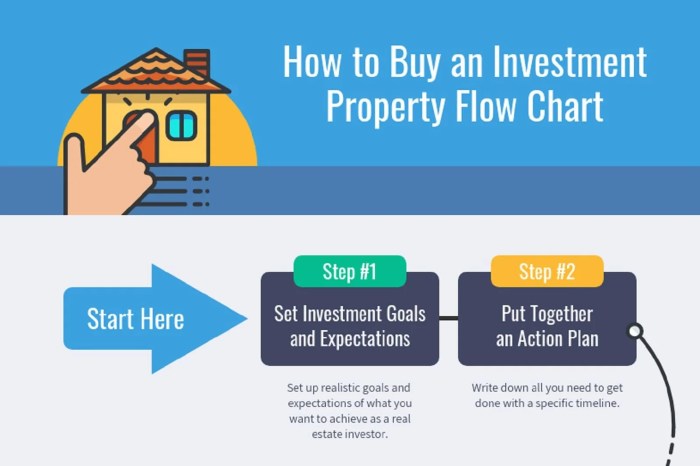How to purchase an investment property with no money down is a question many aspiring real estate investors ponder. This guide explores various creative financing strategies, enabling you to navigate the complexities of acquiring investment properties without significant upfront capital. We’ll delve into methods like lease options, subject-to mortgages, and partnerships, examining their advantages and disadvantages. Through real-world examples and practical advice, we aim to empower you to confidently pursue your real estate investment goals, even with limited funds.
Successfully navigating the path to no-money-down property ownership requires careful planning, meticulous research, and shrewd negotiation. This guide provides a comprehensive framework, covering everything from identifying suitable properties and securing financing to understanding the legal and tax implications, and finally, building long-term wealth through strategic property management. We’ll equip you with the knowledge and tools to make informed decisions and mitigate potential risks.
Understanding No-Money-Down Strategies

Acquiring investment properties without significant upfront capital requires creative financing and a thorough understanding of available strategies. While the term “no money down” is often used, it usually implies minimal out-of-pocket expenses rather than a complete absence of funds. Several methods can minimize your initial investment, allowing you to leverage other people’s money and resources to build your real estate portfolio.
Various methods exist for acquiring investment properties with minimal upfront capital. These strategies often involve leveraging existing assets, partnering with others, or employing creative financing techniques. Successful implementation necessitates careful planning, due diligence, and a strong understanding of the risks involved. Each strategy presents a unique set of advantages and disadvantages that must be carefully weighed against your individual financial situation and investment goals.
Lease Options
A lease option, also known as a lease-purchase agreement, allows a buyer to lease a property with an option to purchase it at a predetermined price within a specified timeframe. The buyer typically pays a higher-than-market rent, with a portion of that rent credited towards the purchase price. This strategy requires minimal upfront capital beyond the lease payments and option fee, allowing the buyer to assess the property’s suitability and improve their financial standing before committing to the full purchase.
A successful case study involved a young investor who secured a lease option on a multi-family property, using the rental income to cover lease payments and save for the eventual down payment. Over two years, they built equity and improved the property’s value, ultimately purchasing it at a favorable price.
Subject-To Mortgages
In a subject-to mortgage, the buyer assumes the seller’s existing mortgage without refinancing. The seller remains liable for the loan, while the buyer makes the mortgage payments to the lender. This strategy allows for the acquisition of properties without incurring new debt or needing a large down payment. However, it’s crucial to thoroughly examine the existing mortgage terms and the property’s condition before entering such an agreement.
A real-world example is an experienced investor who acquired a distressed property using a subject-to mortgage, then renovated it and sold it for a significant profit, paying off the existing mortgage and keeping the profits.
Partnerships
Partnering with other investors can significantly reduce the financial burden of acquiring investment properties. This can involve forming a limited liability company (LLC) or other partnership structure, where each partner contributes capital, expertise, or other resources. Partnerships can be particularly effective when combining financial resources with the experience and skills of other investors. For instance, an investor with strong financial backing could partner with a seasoned real estate professional possessing extensive renovation and property management skills.
This synergy allows for the acquisition and management of larger, more complex properties than either partner could achieve independently.
Comparison of No-Money-Down Strategies
| Strategy | Pros | Cons | Risk Level |
|---|---|---|---|
| Lease Option | Minimal upfront capital, time to assess property | Higher rent payments, potential loss of option fee | Medium |
| Subject-To Mortgage | No new debt, potential for quick profit | Seller remains liable, risk of foreclosure | High |
| Partnerships | Shared risk and capital, combined expertise | Potential for disagreements, shared profits | Medium |
Finding Suitable Investment Properties

Securing a profitable investment property with no money down requires a strategic approach to property selection. Understanding the key criteria for choosing the right property is paramount to the success of your investment. This involves careful research, analysis, and due diligence, focusing on factors that directly impact profitability and minimize risk.Finding the ideal investment property for a no-money-down strategy necessitates a different approach than traditional property purchasing.
The focus shifts to identifying properties with strong cash flow potential, favorable seller financing options, or opportunities to leverage existing equity. This section will detail the critical steps involved in identifying and evaluating such properties.
Key Criteria for Selecting Profitable Investment Properties
Profitable investment properties suitable for no-money-down strategies share several key characteristics. High rental income potential is crucial to cover expenses and generate positive cash flow. A desirable location, with strong tenant demand and appreciation potential, minimizes vacancy risks and maximizes long-term value. The property’s condition and required repairs significantly impact overall profitability, so a thorough assessment is necessary.
Finally, understanding the available financing options, such as seller financing or lease-options, is essential for executing a no-money-down strategy.
Researching and Analyzing Potential Properties
The process of researching and analyzing potential properties involves a systematic approach. Begin by identifying target markets based on factors like rental demand, property values, and local economic conditions. Utilize online resources like real estate websites, property records, and local market reports to identify properties meeting your criteria. Then, conduct thorough due diligence, including property inspections, rental market analysis, and cost estimations for repairs and maintenance.
This ensures a realistic understanding of the property’s potential return on investment. For example, analyzing comparable rental properties in the same area helps to determine a realistic rental income projection. A thorough inspection will uncover hidden issues, allowing for accurate budgeting of repair costs.
Property Due Diligence Checklist for No-Money-Down Investors
Before committing to any investment, a comprehensive due diligence checklist is crucial. This checklist ensures all aspects of the property and transaction are thoroughly examined. A key aspect is verifying the property’s title and ownership, ensuring there are no liens or encumbrances. Thoroughly reviewing the property’s condition through professional inspections helps to identify potential repair costs and future maintenance expenses.
Analyzing the local rental market, including vacancy rates and rental income potential, helps to determine the property’s financial viability. Finally, scrutinizing the terms of any seller financing or lease-option agreement is crucial to understanding your financial obligations and potential risks. This rigorous approach helps mitigate potential financial setbacks.
Resources for Finding Off-Market Deals or Properties with Seller Financing
Locating off-market deals or properties with seller financing requires a proactive approach. Networking with real estate agents specializing in investment properties, attending real estate investment workshops, and engaging with wholesalers can significantly increase your chances of finding suitable opportunities. Directly contacting property owners, particularly those facing financial difficulties or seeking quick sales, can also yield promising leads. Online platforms specializing in investment properties often list opportunities that might not be publicly advertised.
Furthermore, utilizing property records and tax assessments can identify properties with potential for seller financing. This multifaceted approach enhances the probability of discovering profitable, no-money-down investment opportunities.
Securing Financing and Negotiating Deals: How To Purchase An Investment Property With No Money Down

Securing financing and negotiating favorable terms are crucial steps in acquiring an investment property with minimal or no down payment. This process involves skillful negotiation with sellers and strategic application for financing options that cater to your specific financial situation. Success hinges on a thorough understanding of various financing instruments and a proactive approach to improving your creditworthiness.Negotiating with sellers to secure favorable terms often involves exploring options beyond traditional mortgages.
Effective negotiation requires a well-defined strategy and a clear understanding of the seller’s motivations and the property’s market value. Understanding the seller’s urgency to sell, their financial situation, and their desired outcome can significantly influence the negotiation process.
Seller Financing and Lease-Option Agreements
Seller financing allows the seller to act as the lender, providing financing for the purchase of their property. This can be particularly advantageous for buyers with limited credit or down payment funds. A lease-option agreement, on the other hand, combines a lease with an option to purchase the property at a predetermined price within a specific timeframe. Both options offer pathways to homeownership with less upfront capital.
The key difference lies in the immediate transfer of ownership. In seller financing, ownership transfers immediately, while in a lease-option, ownership is deferred until the option to buy is exercised. The terms and conditions of both seller financing and lease-option agreements are highly negotiable and should be carefully reviewed by legal counsel before signing. For example, a seller might offer a lease-option with a below-market rent to compensate for a lower purchase price, or a seller financing deal with a higher interest rate in exchange for a smaller down payment.
Thorough due diligence and legal advice are essential for structuring these agreements to minimize risk.
Applying for Financing with Minimal or No Down Payment
Securing financing with minimal or no down payment requires a strong credit score and a stable financial profile. This involves meticulously documenting your income, expenses, and assets. Several financing options exist, including FHA loans, VA loans, and USDA loans, which often require lower down payments than conventional mortgages. A step-by-step guide to applying for such loans typically includes pre-qualification, gathering necessary documentation (income verification, credit reports, tax returns), application submission, appraisal, and loan closing.
The specific requirements and processes vary among lenders, and careful comparison shopping is recommended to secure the most favorable terms. For instance, an FHA loan may require a credit score above 580 for a 3.5% down payment, while a VA loan requires no down payment for eligible veterans. Understanding these nuances is vital for a successful application.
Strategies for Improving Credit Score and Financial Profile
Improving your credit score and financial profile is a crucial step towards qualifying for financing. Strategies include paying bills on time, reducing credit utilization, and avoiding new credit applications. Dispute any errors on your credit report, and monitor your credit score regularly. A strong financial profile includes demonstrating a stable income, low debt-to-income ratio, and sufficient savings.
Building a solid financial foundation takes time and discipline, but it significantly increases your chances of securing favorable financing terms. For example, paying off even a small portion of existing debt can noticeably boost your credit score, making you a more attractive candidate for lenders. Similarly, consistently making on-time payments on all credit accounts demonstrates financial responsibility.
Comparison of Seller Financing Agreements
Different types of seller financing agreements exist, each with unique implications. These include land contracts, installment sales contracts, and wraparound mortgages. A land contract involves a direct agreement between the buyer and seller, where the buyer makes payments to the seller until the full purchase price is paid. An installment sales contract is similar, but often involves more formal legal protections.
A wraparound mortgage involves the seller retaining their existing mortgage while the buyer makes payments to them, encompassing both the existing mortgage and a new financing component. Each agreement carries different levels of risk and legal implications. Understanding these nuances is crucial for selecting the most suitable option for your specific circumstances. For example, a land contract might offer flexibility but may lack the legal protections of a more formal installment sales contract.
Choosing the right agreement requires careful consideration and legal counsel.
Managing and Maintaining the Property

Successfully managing an investment property, especially one acquired with no money down, requires a proactive and strategic approach. Careful planning and execution in property management, maintenance, tenant selection, and budgeting are crucial for maximizing returns and minimizing risks. This section details effective strategies for each of these key areas.
Effective Property Management Strategies
Effective property management is paramount to maximizing rental income and minimizing vacancies. This involves a combination of efficient administrative tasks, proactive communication with tenants, and prompt responses to maintenance requests. A well-managed property not only attracts and retains quality tenants but also protects the investment’s value. Consider utilizing professional property management services, especially if you lack the time or experience to handle these responsibilities effectively.
This can alleviate the burden of day-to-day tasks, allowing you to focus on broader investment strategies. Alternatively, if self-managing, develop a robust system for tracking rent payments, maintenance requests, and tenant communication.
Property Maintenance and Repair Planning
A detailed plan for handling property maintenance and repairs is essential for preserving the property’s value and minimizing unexpected expenses. This includes establishing a preventative maintenance schedule (e.g., annual inspections, HVAC servicing) to address potential issues before they escalate into costly repairs. Creating a dedicated maintenance budget is crucial, allocating funds for routine upkeep and anticipating potential major repairs.
When selecting contractors, obtain multiple quotes, verify licensing and insurance, and check online reviews to ensure quality and reliability. Maintaining thorough records of all repairs, including dates, costs, and contractor information, is essential for tax purposes and future reference.
Tenant Screening and Selection, How to purchase an investment property with no money down
Thorough tenant screening is vital for minimizing risks associated with late rent payments, property damage, and evictions. This involves a comprehensive background check, including credit history, rental history, and criminal record verification. Verifying employment and income is also crucial to assess the tenant’s ability to pay rent consistently. Utilizing professional screening services can streamline this process and provide a more comprehensive assessment of potential tenants.
Clearly defined lease agreements that Artikel tenant responsibilities and consequences for breaches are also essential for protecting your investment.
Sample Budget for Managing an Investment Property
The following budget illustrates potential expenses for managing an investment property acquired with no money down. Remember that these figures are estimates and can vary significantly based on location, property type, and specific circumstances.
| Expense Category | Monthly Estimate | Annual Estimate | Notes |
|---|---|---|---|
| Mortgage Payment | $1,000 | $12,000 | This assumes a no-money-down mortgage. |
| Property Taxes | $200 | $2,400 | Based on local tax rates. |
| Homeowners Insurance | $100 | $1,200 | Coverage varies based on location and coverage levels. |
| Maintenance & Repairs | $150 | $1,800 | Includes routine maintenance and potential repairs. |
| Vacancy Allowance | $100 | $1,200 | Covers periods without tenants. |
| Property Management Fees (Optional) | $150 | $1,800 | If using a property management company. |
| Capital Expenditures (Annual) | – | $500 | For larger repairs or upgrades. |
| Total Monthly Expenses | $1,700 | – | |
| Total Annual Expenses | – | $21,900 |
Building Long-Term Wealth

Investing in real estate, particularly with no-money-down strategies, offers a powerful pathway to building substantial long-term wealth. This involves not just acquiring properties but strategically managing them to maximize returns and mitigate risks over an extended period. The key lies in understanding the dynamics of property appreciation, leveraging financing options, and diversifying your portfolio to minimize exposure to market fluctuations.Successful long-term strategies rely on a combination of proactive management and a long-term perspective.
Unlike short-term trading, the focus here is on gradual, consistent growth built upon sound financial planning and strategic property selection. This approach allows for weathering market downturns and capitalizing on opportunities for increased profitability as the market evolves.
Refinancing and Property Appreciation
Refinancing allows you to unlock equity built up in your property. As your property appreciates in value, its market worth increases, thereby increasing the amount of equity you own. This equity can be tapped through refinancing, allowing you to either pay down existing loans, purchase additional properties, or access funds for other investments. For example, consider a property initially purchased for $150,000.
After five years, its value rises to $200,000. Refinancing could provide access to the $50,000 in equity, which could be used as a down payment on another property, thus accelerating wealth building. This strategy effectively leverages the initial no-money-down investment to create a snowball effect of property acquisitions.
Diversification in Real Estate Investment Portfolio
Diversification is crucial for mitigating risk in any investment portfolio, and real estate is no exception. Instead of concentrating on a single property or location, spreading your investments across different property types (e.g., residential, commercial), geographical locations, and even asset classes (e.g., REITs alongside physical properties) reduces the impact of potential setbacks in one area. For example, a downturn in the residential market in one city might be offset by strong performance in a different market or by returns from a commercial property investment.
A diversified portfolio ensures greater resilience against market fluctuations and provides a more stable foundation for long-term wealth creation.
Creating a Long-Term Real Estate Investment Plan
A well-defined plan is essential for achieving long-term success in real estate investment. This plan should encompass several key steps:
- Define Financial Goals: Clearly Artikel your financial objectives, including the desired level of wealth accumulation and your investment timeline.
- Assess Risk Tolerance: Determine your comfort level with risk and adjust your investment strategy accordingly. Higher-risk strategies, such as leveraging significant debt, may offer greater potential returns but also carry greater potential losses.
- Develop an Investment Strategy: Choose a suitable investment strategy based on your goals and risk tolerance, considering factors such as property type, location, and financing options. This could include focusing on specific niches, such as student housing or short-term rentals, based on market analysis and personal expertise.
- Identify and Analyze Properties: Conduct thorough due diligence on potential properties, considering factors such as location, market trends, rental income potential, and repair costs. This requires in-depth research and may involve seeking expert advice.
- Secure Financing: Explore various financing options, including no-money-down strategies, and choose the most suitable one based on your financial situation and investment strategy. Understanding the terms and conditions of each loan is paramount.
- Implement and Monitor: Execute your investment plan and continuously monitor your portfolio’s performance, adjusting your strategy as needed to adapt to changing market conditions and opportunities. Regular reviews and adjustments are crucial for long-term success.
Conclusion

Acquiring investment properties with no money down presents a unique opportunity to build wealth in real estate, but it requires a strategic approach and a thorough understanding of the market. By carefully considering the various financing options, diligently researching potential properties, and diligently managing your investment, you can significantly increase your chances of success. Remember, thorough due diligence, strong negotiation skills, and a long-term vision are crucial for navigating this path effectively and achieving your financial goals.
This guide serves as a stepping stone; further research and professional advice will further enhance your journey.